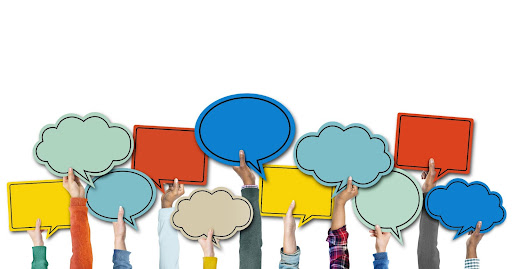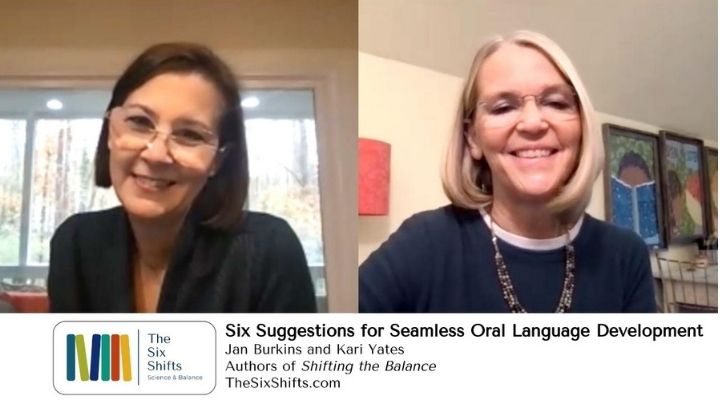What’s oral language development got to do with reading, anyway?
Well, it turns out . . . a whole lot.

As we explain in Chapter 1 of Shifting the Balance, reading comprehension doesn’t begin with reading; it begins with comprehension of spoken language.
And as luck would have it- although it is NOT naturally wired for reading – the human brain IS wired for spoken language.
So, from the moment we are born until the moment we leave this earth, our phonological processing systems are busy scanning the environment for meaningful chunks of language, looking for patterns, and filing away the things it hears.
Which is really important! Because later success with reading comprehension piggybacks on the language we’ve learned and background we’ve built about this world.
So, making space for conversation really matters. And yet, it doesn’t have to be complicated.
Would you like to see some really fun and authentic oral language development in action? Then check out this video of a young dad engaging his adorable son in the back and forth turn-taking that later becomes the heart of successful verbal interaction.
Drawing on the skills that this daddy demonstrates, today we offer six ways to weave language development seamlessly into the creases of whatever is already going on in your classroom.
![]()
Use interesting words.
All day long, we choose the words we will use in our conversations with children. Using more interesting, accurate, and sophisticated vocabulary with children is an investment in the development of their mental dictionary. So, rather than using the word big . . . how about colossal? Rather than sitting on the edge of the rug. . . . how about perimeter? Rather than easy . . . how about effortless?
 Ask questions that require more than a quick one-word answer.
Ask questions that require more than a quick one-word answer.
We all know this one already, but if you’re like us, a reminder every now and then is helpful. A few of our favorite high-utility sentence starters for any time of day include:
- What are you noticing?
- What does that make you think about?
- Why do you think that happened?
- What seems most important to pay attention to?
- How would you describe what you saw (experienced, etc)?
 Leave some wait time for processing.
Leave some wait time for processing.
It’s so easy to jump in the first time there is a lull in the conversation or that the child hesitates. But giving children time to formulate their thoughts and then find the words to express them takes time. When we practice zipping our own lips for a few moments longer, we may be surprised with what our conversation partners are able to offer.
 Let your body do some talking.
Let your body do some talking.
Whether through a smile, a nod, or an affirming gesture, we can use our nonverbal interactions to communicate to children that we are listening, that their thoughts are important, and that we believe in them, even if it takes them a few extra seconds to find the right words and put their thoughts together.
 Repeat and expand.
Repeat and expand.
This is a simple strategy used to reinforce, extend, and clarify student language choices. It comes from Grover Whitehurst’s research on dialogic reading and is really simple to implement with just a bit of practice. Here’s the process:
- Ask a question that requires more than a yes/no response.
What is the dog doing?
- Let the child respond.
The dog is scratching at the box.
- Repeat what the child says. You can include a bit of affirmation.
Yes. The dog is scratching at the box.
- Expand, or add on to, what the child said.
He was trying to open the carton.
 Punctuate conversation with pauses.
Punctuate conversation with pauses.
When it comes to helping children better digest and understand the language we use with them, it’s not so much the speed of our conversation that matters as it is the pausing. Paying attention to where we insert pauses, and doing so in places that provide punctuation (think of where you would place a comma, a period, or other punctuation in writing) provides the listening brain an opportunity to digest what’s being said in meaningful chunks. So, don’t be scared to insert more purposeful pauses in your instruction and conversation throughout the day. The listeners around you will appreciate it.
Oral language development doesn’t have to wait. You can weave it seamlessly into the creases of your days in dozens of ways. And this work of helping children learn to comprehend speech is essential to later reading comprehension.
You could say, supporting oral language development today is an investment in reading comprehension tomorrow.
For further discussion, check out the short video we made that goes along with this post.




I would like to share these tips in a newsletter for parents, would that be OK?
Of course. Spread the word. Just please offer credit.
I like the way you frame the “listening brain”
With the opportunity to digest meaning chucks of language.
I like the way you framed the “listening brain” with the opportunity to digest meaningful chucks of language.
Thanks, Judy. The more we learn about the language processing systems of the brain, the more excited we are about elevating listening and language development opportunities in the classroom.
I love the expanding of sentences using creative words.
As an SLP, this is spot on! We always encourage parents and caregivers to apply these strategies! Thank you for sharing these with others!
Laura,
Thanks for reaching out. These are really great strategies for caregivers as well. The earlier the better! 🙂
Kari and Jan